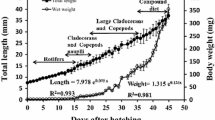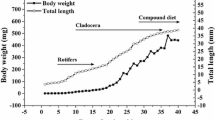Abstract
Mechanisms initiating trypsinogen secretion were studied in laboratory reared herring larvae (Clupea harengus L.) exposed to physical and chemical stimuli. Pancreatic secretion of trypsinogen was quantified for each stimulus type as the increase above pre-stimulus level of intestinal trypsin content. Larval prey types were: nauplii, copepodites or adult Acartia tonsa, small polystyrene spheres (diameter 94 μm), small (diameter 79 μm) or large (diameter 170 μm) polystyrene-latex spheres. Intestinal trypsin content can be expressed as a function of two variables: meal size and content of pancreatic trypsinogen. Trypsinogen secretion increases with different prey items in the order: small spheres, nauplii and copepodites. Larvae which eat large spheres secrete more enzyme than if fed small spheres but trypsinogen secretion is similar in fish larvae fed copepodites and large spheres. The fact that the size of non-biodegradable particles exerts a major control over trypsinogen secretion suggests neural — as opposed to chemically mediated — initiation of secretion. A cephalic phase of secretory stimulation could not be demonstrated during swallowing of copepods or exposure for 2 to 3 h to compounds which leak from live copepodites. As cephalic and gastric phases of secretory stimulation are absent, initiation of trypsinogen secretion must take place in the intestine. Larval herring retain trypsin in the intestine. Ca. 4.5 h after a meal, 3/4 of the enzyme is located in the intestinal fluid, presumably available for hydrolysis of subsequent meals, and the high proportion (ca. 25%) of the pancreatic trypsinogen content which is secreted for copepodite prey may thus not be energetically wasteful for the larvae.
Similar content being viewed by others
Literature cited
Castel, J., Veiga, J. (1990). Distribution and retention of the copepod Eurytemora affinis hirundoides. Mar. Biol. 107: 119–128
Fänge, R., Grove, D. (1979). Digestion. In: Hoar, W. S., Randall, D. J., Brett, J. R. (eds.) Fish physiology 8. Academic Press, New York, p. 161–260
Green, G. M., Lyman, R. L. (1972). Feedback regulation of pancreatic enzyme secretion as a mechanism for trypsin inhibitor-induced hypersecretion in rats. Proc. Soc. exp. Biol. Med. 140: 1–12
Green, G. M., Olds, B. A., Matthews, G., Lyman, R. L. (1973). Protein as a regulator of pancreatic enzyme secretion in the rat. Proc. Soc. exp. Biol. Med. 142: 1162–1167
Govoni, J., Boehlert, G. W., Watanabe, Y. (1986). The physiology of digestion in fish larvae. Envir. Biol. Fish. 16 (1–3): 59–77
Grendell, J. H., Tseng, H. C., Rothman, S. S. (1984). Regulation of digestion. 1. Effects of glucose and lysine on pancreatic secretion. Am. J. Physiol. 246: G445-G450
Hirschowitz B. I. (1989). Neural and hormonal control of gastric secretion. In: Schultz, S. G., Forte, J. G., Rauner, B. B. (eds.) Handbook of physiology, Sect. 6. The gastrointestinal system, Vol. 8. American Physiology Society, Oxford University Press, New York, p. 1–759
Hjelmeland, K., Huse, I., Jørgensen, T., Molvik, G., Raa, J. (1984). Trypsin and trypsinogen as indices of growth and survival potential of cod (Gadus morhua L.) larvae. In: Dahl, E., Danielsen, D. S., Moksnes, E., Solemdal, P. (eds.) Flødevigen Rapporter 1. The propagation of cod Gadus morhua L. Institute of Marine Research, Flødevigen Biological Station, Flødevigen, Norway, p. 189–202
Hjelmeland, K., Jørgensen, T. (1985). Evaluation of radioimmunoassay as a method to quantify trypsin and trypsinogen in fish. Trans. Am. Fish. Soc. 114: 619–621
Hjelmeland, K., Pedersen, B. H., Nilssen, E. M. (1988). Trypsin content in intestines of herring larvae, Clupea harengus ingesting inert polystyrene spheres or live crustacea prey. Mar. Biol. 98: 331–335
Larsson, L.-I., Rehfeld, J. F. (1977). Evidence for a common evolutionary origin of gastrin and cholecystokinin. Nature, Lond. 269 (5626): 335–338
Miller, C. B., Johnson, J. K. (1977). Growth rules in the marine copepod genus Acartia. Limnol. Oceanogr. 22 (2): 326–335
Pedersen, B. H. (1984). The intestinal evacuation rates of larval herring (Clupea harengus L.) predating on wild plankton. Dana 3: 21–30
Pedersen, B. H., Hjelmeland, K. (1988). Fate of trypsin and assimilation efficiency in larval herring (Clupea harengus) following digestion of copepods. Mar. Biol. 97: 467–476
Pedersen, B. H., Nilssen, E. M., Hjelmeland, K. (1987). Variations in the content of trypsin and trypsinogen in larval herring (Clupea harengus) digesting copepod nauplii. Mar. Biol. 94: 171–181
Pedersen, B. H., Ugelstad, I., Hjelmeland, K. (1990) Effects of a transitory, low food supply in the early life of larval herring (Clupea harengus) on mortality, growth and digestive capacity. Mar. Biol. 107: 61–66
Rothman, S. S. (1974). Molecular regulation of digestion: short term and bond specific. Am. J. Physiol. 226 (1): 77–83
Rothman, S. S. (1989). Regulation of digestive reactions by the pancreas. In: Schultz, S. G., Forte, J. G., Rauner, B. B. (eds.) Handbook of physiology, Sect. 6. The Gastrointestinal System, Vol. 8. American Physiology Society, Oxford University Press, New York, p. 1–759
Sandholm, M., Scott, M. L. (1979). Binding of lipase, amylase and protease to the intestinal epithelium as affected by carbohydrates and lectins in vitro. Acta vet. scand. 20: 329–342
Schneeman, B. O., Lyman, R. L. (1975). Factors involved in the intestinal feedback regulation of pancreatic enzyme secretion in the rat. Proc. Soc. exp. Biol. Med. 148: 897–903
Schulz, I. (1989). Signaling transduction in hormone — and neurotransmitter — induced enzyme secretion from the exocrine pancreas. In: Schultz, S. G., Forte, J. G., Rauner, B. B. (eds.). Handbook of physiology, Sect. 6. The Gastrointestinal System, Vol. 8. American Physiology Society, Oxford University Press, New York, p. 1–759
Silen, W. (1974). Peptic ulcer. In: Wintrobe M. M., Thorn, G. W., Adams, R. D., Braunwald, E., Issesbacher, K. J., Petersdorf, R. G. (eds.) Harrison's principles of internal medicine, 7th edn., McGraw-Hill, New York, p. 1–2044
Snodgrass, P. J. (1974). Diseases of the pancreas. In: Wintrobe, M. M., Thorn, G. W., Adams, R. D., Braunwald, E., Issesbacher, K. J., Petersdorf, R. G. (eds.) Harrison's principles of internal medicine, 7th edn., McGraw-Hill, New York, p. 1–2044
Snook, J. T. (1965). Dietary regulation of pancreatic enzyme synthesis, secretion and inactivation in the rat. J. Nutr. 87: 297–305
Ueberschär, B. F. R. (1988). Determination of the nutritional condition of individual marine fish larvae by analyzing their proteolytic enzyme activities with a highly sensitive fluorescence technique. Meeresforsch. Rep. mar. Res. 32: 144–154 (Ber. dt. wiss. Kommn Meeresforsch.)
Vander, A. J., Sherman, J. H., Luciano, D. S. (1990). Human physiology, 5th edn. McGraw-Hill, New York
Williams, J. A., Burnham, D. B., Hootman, S. R. (1989). Cellular regulation of pancreatic secretion. In: Schultz, S. G., Forte, J. G., Rauner, B. B. (eds.) Handbook of physiology, Sect. 6. The gastrointestinal system, Vol. 8. American Physiology Society, Oxford University Press, New York, p. 1–759
Author information
Authors and Affiliations
Additional information
Communicated by T. Fenchel, Helsingør
Rights and permissions
About this article
Cite this article
Pedersen, B.H., Andersen, K.P. Induction of trypsinogen secretion in herring larvae (Clupea harengus). Marine Biology 112, 559–565 (1992). https://doi.org/10.1007/BF00346173
Accepted:
Issue Date:
DOI: https://doi.org/10.1007/BF00346173




